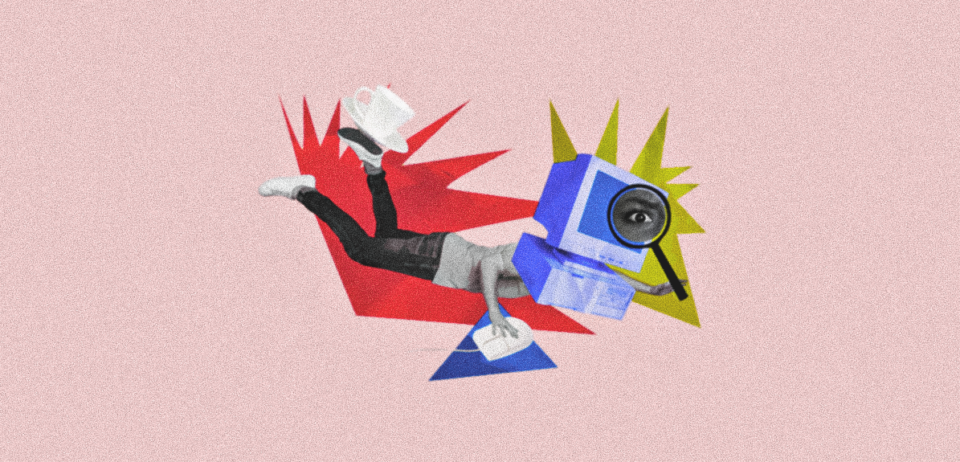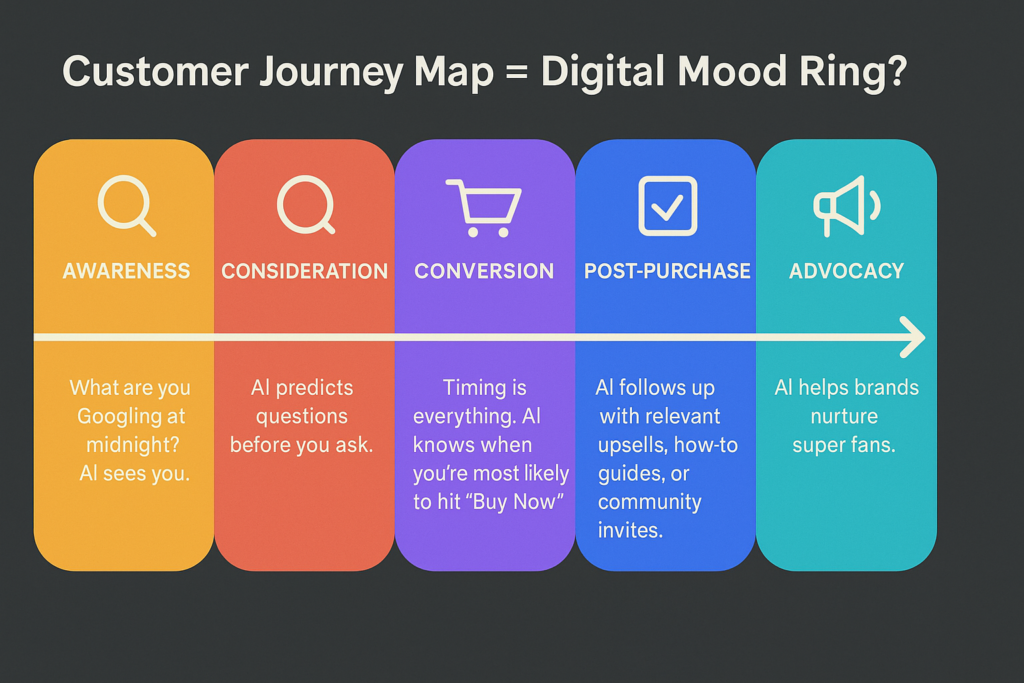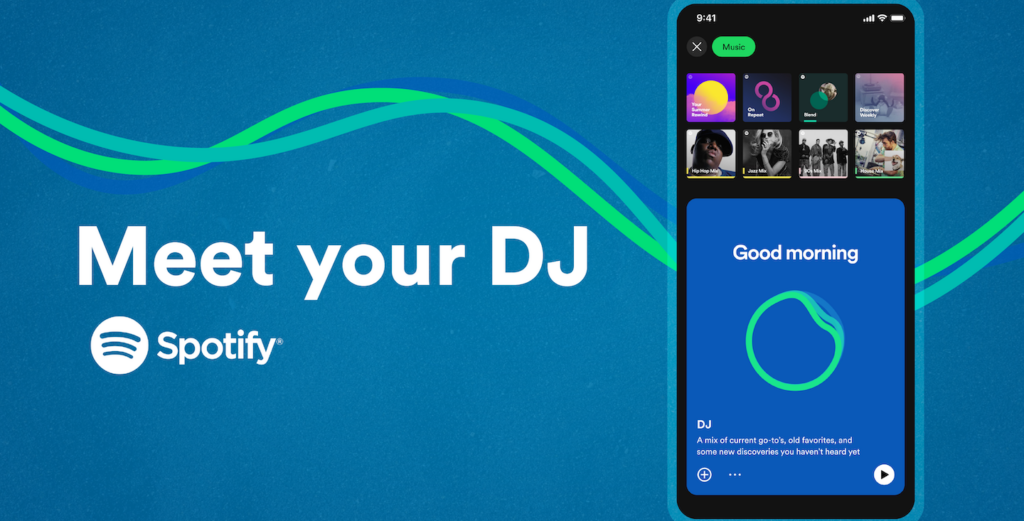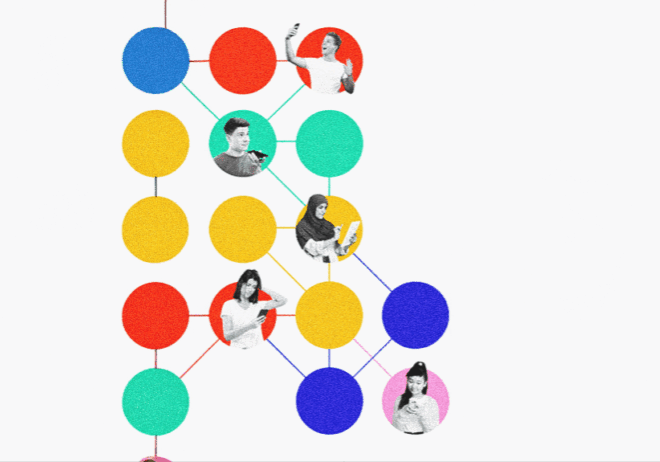
AI Knows You Better Than You Think: The 2025 Guide to Brand Awareness and Loyalty
Have you ever felt like a brand knows you a little too well? Like, when your phone lights up at 2 AM with an ad for that neon green water bottle you almost bought — but didn’t? Or when your Monday morning Spotify playlist cues up exactly the song you needed? You never checked out. You never even added it to your cart. Yet somehow, it finds its way back to you. Spoiler: It’s not luck, it’s not telepathy. It’s AI — and it’s reshaping brand awareness as we know it.
Not too long ago, the customer journey map was a static diagram: Awareness → Consideration → Purchase → Retention → Advocacy. But in 2025, it’s something else entirely — a dynamic, algorithm-fueled system that reads your clicks, quirks, and cravings in real time. It’s not just about buying anymore; it’s about being understood.
Creepy? Cool? Maybe both.
Let’s unpack how AI is quietly turning your daily scroll into a seamless, data-driven brand experience — and why brand awareness is no longer just the first step in the customer journey map, but an ever-evolving loop.
Here’s how AI is the ultimate hype beast of customer journey mapping
What even is a customer journey map in 2025? Let’s break it down.
Artificial Intelligence is the fuel behind this evolution. Every time you scroll, click, or pause, it’s an AI-powered ecosystem that keeps updating. Brands today are tracking micro-moments across devices, platforms, and moods to personalize every interaction. It’s like your shopping habits got a personal DJ, mixing real-time experiences based on your vibe.
Here’s how it’s turning traditional mapping into predictive art:
Behavioral prediction
AI doesn’t wait for you to tell it what you want. It watches, learns, and delivers—before you know what you’re looking for. Using machine learning models, it tracks your digital body language and projects your next move.
Ever felt like a website just gets you? From product recommendations to email subject lines, AI is crafting content that feels eerily on-point. It’s not stalking—it’s strategy.
Real-time adaptation
Journey maps aren’t “one and done.” AI adapts them in real time. Changed your mind halfway? The system shifts your route without skipping a beat. Like Google Maps, but for eCommerce.
Gen Z x AI: Let’s understand the digital touchpoints
We’re not just digital natives—we’re digital snipers. We scroll, swipe, and shop with intention, dodging irrelevant content like pros and calling out cringe ads before they finish loading.
We expect brands to vibe with our values and meet us in the moment. That’s where AI-powered customer journey mapping steps in. It’s not just about grabbing attention, it’s about building trust through smart, timely, and actually relevant touchpoints. When a brand gets it right, it doesn’t feel pushy; it feels like magic!
And let’s be real: our digital lives are all over the place.
From Instagram DMs to voice searches, our footprints are scattered like confetti. AI is the one sweeping it all up and connecting the dots. It’s analyzing our Reddit rants, syncing our clicks across platforms, and even detecting our moods through text and tone. Whether we buy through Alexa after ignoring three emails or leave a “meh” comment on a YouTube ad, AI is watching (respectfully) and learning.
In 2025, the customer journey map isn’t linear—it’s a vibe. And AI? It’s keeping up with every step.
Customer journey map = Digital mood ring?
Kind of, yeah.
In 2025, a customer journey map is less about fixed steps and more about mood-based marketing moments. AI maps don’t just track what users do—they feel the emotional temperature of each phase.
Before diving into the details, here’s something to feel the waters:

Awareness
What are you Googling at midnight? AI sees you. Brands are learning to enter the convo gently, not with “BUY NOW” energy but with memes, reels, or value-first blog posts.
Consideration
AI predicts questions before you ask. Think chatbot convos that already have your vibe checked.
Conversion
Timing is everything. AI knows when you’re most likely to hit “Buy Now”—down to the day, hour, and device.
Post-Purchase
AI follows up with not just receipts but relevant upsells, how-to guides, or community invites.
Advocacy
The journey doesn’t end at purchase. AI helps brands nurture super fans—offering sneak peeks, reward programs, or TikTok collabs.
Brands that are nailing the AI journey game
It’s one thing to talk about AI-driven customer journey maps, but the real magic happens when brands actually walk the talk.
From beauty to music to fitness, a few companies use AI to turn personalization into an art form:
Sephora
Using AI to recommend products based on skin type, past purchases, and even current weather in your location. Your moisturizer just got climate aware.

Spotify
Beyond Spotify playlists, AI curate’s audio ads and artist suggestions that align with your Monday mood vs. your Friday hype.

Nike
Personalized drops based on browsing history, size preferences, and even your activity from fitness apps. Your shoes might know you’re ready for a 10K before you do.

To be clear, artificial intelligence (AI) reads patterns, not minds! Let’s understand that better.
Control, consent & the remix of the customer journey
Although predicted personalization can seem uncanny, it balances being useful and intrusive. Additionally, trust is crucial for Gen Z and millennials. If there are transparent permissions, sincere opt-outs, and complete control over our data, we’re cool with AI curating our experience.
The old-school marketing funnel? That’s ancient history. Today’s customer journey map looks more like a remix, dynamic, emotional, and totally unpredictable. Some days we’re just vibing, others we’re ready to drop money.
Smart AI adapts the rhythm in real time by following the emotions rather than just the funnel.
Cut to the chase
AI is turning static customer journey maps into dynamic, predictive powerhouses. It tailors each stage, from advocacy to awareness, according to timing, behavior, and emotion. Gen Z expects relevance, ethics, and mood-matching. The future isn’t about predicting what you’ll buy, it’s about knowing why you buy and meeting you there.


